OUR LADY OF THE PILLAR TIMELINE
40 A.D. (January 2): The reported date of the Marian apparition to Santiago in Zaragoza.
1299: The first written reference to the dedication of the Pillar occurred.
1471: The first written reference to the apparition in flesh of Mary to Santiago occurred. According to this text, she was carried by a choir of angels from Palestine to Zaragoza.
1613: Zaragoza’s city council proclaimed October 12 the day of the Virgin of the Pillar as local public holiday.
1640: The Miracle of Calanda took place. The Virgin of the Pillar restored Miguel Pellicer’s mutilated leg.
1653: Zaragoza’s city council proclaimed the Virgin of the Pillar patroness of the city.
1675 (February 2): Pope Clement X unified the councils of canons of the Cathedral of the Savior and the Church dedicated to the Pillar and declared the latter a co-cathedral.
1678: The Aragonese Corts declared the Virgin of the Pilar to be patroness of Aragon and her apparition on January 2 to be a public holiday in the Kingdom of Aragon.
1723: The Sacred Congregation of Rites recognized the apparition as a pious tradition and inserted it in the lessons of the office on October 12 as an octave (eight consecutive days of religious festivities) of second class-importance in the liturgical year.
1681-1730: The modern baroque Cathedral of Our Lady of the Pillar was constructed.
1754-1765: The Cathedral was refurbished by Architect Ventura Rodríguez.
1804: Charles IV of Spain granted October 12 as Feasts of Precept in the Archdiocese of Zaragoza.
1807: Pope Pius VII granted October 12 as a double octave (eight consecutive days of religious festivities) of the first class-importance in the liturgical year in Aragon.
1808 (May 17): There was an apparition of a palm-like cloud over the Cathedral of the Pillar during the French invasion of the Peninsula.
1808 (June 15): An apparition of the Virgin of the Pillar occurred in the Battle of Las Heras during the Napoleonic Siege of Zaragoza.
1815: Pope Pius VII granted January 2 as a double octave (eight consecutive days of religious festivities) of the second class-importance in the liturgical year in Aragon.
1863: Pope Pius IX extended to the Kingdom of Spain the reach of 1807 papal granting.
1863-1872: The refurbishing of the Cathedral planned by Ventura Rodríguez was completed.
1880: The first National Pilgrimage to the Cathedral of the Pillar too place.
1889: The brotherhood of the Glass Rosary of the Pillar was founded.
1901: Anticlerical riots occurred in Zaragoza during the celebration of the Jubilee.
1902: The religious lay female society “Corte de honor de damas de Nuestra Señora del Pilar,” was founded.
1904: The Cathedral was declared a national monument by the Spanish government.
1905: Pius X granted the image of the Virgin of the Pillar a canonical coronation.
1907: The second tower of the Cathedral was built.
1908: The Virgin of the Pillar was declared by the government Captain General of the Spanish Army during the 100th anniversary of the Spanish Peninsular War.
1908: The Marian International Congress met in Zaragoza.
1908: The Chilean bishop, Ramón Ángel Jara, offered to the Pillar nineteen flags of Latin-American Republics blessed by the pope.
1913: Our Lady of the Pillar was declared patroness of the Guardia Civil (Civil Guard).
1927: A national celebration of the Spanish victory in the Rif War in the Cathedral of the Pillar took place.
1928: The religious lay male society “Caballeros de Nuestra Señora del Pilar” was formed.
1932: The image of the Pillar was removed following the separation of church and state during the Spanish Second Republic.
1936 (August 3): The miracle of the non-explosion of three bombs dropped on the Cathedral during the Spanish Civil War occurred.
1937: The dictator Franco consecrated Spain to the Virgin Mary in the Cathedral of the Pillar.
1939: The Cathedral was declared by Franco Santuario de la Raza (Sanctuary of the Race).
1940: The celebration of the 1900th anniversary of the Apparition of the Virgin in Zaragoza took place.
1943: Spain was consecrated to the defense of the Assumption dogma in the Cathedral of the Pillar.
1948: Our Lady of the Pillar was declared patroness of the Consejo Superior de Misiones, which involved the Spanish Ministry of Foreign Offers undertaking the project of sending images of the Pillar across the world.
1948: Pius XII granted the cathedral of the Pillar the title of minor basilica.
1954: There was an inauguration of the square of the Cathedrals with a monument to the “martyrs of the Crusade (1936-1939),” opening a vast space for mass political and religious demonstrations.
1954: Franco consecrated Spain to the Sacred Heart of Mary during de Nacional Marian Congress held in Zaragoza.
1958: The invention of the tradition of a massive flower offering to Our Lady of the Pillar took place.
1961: The last two towers funded by noble woman Leonor Sala were constructed.
1965: The patron saint festival was declared of national tourist interest.
1979: The Fifteenth Marian International Congress held in Zaragoza.
1982: Pope John Paul II visited Zaragoza and the Basilica of Our Lady of the Pillar.
1995: The UEFA Winners’ Cup was offered by Real Zaragoza Team to Our Lady of the Pillar.
FOUNDER/GROUP HISTORY
The worship to the Virgin of the Pillar (El Pilar) arose in the middle of the thirteenth century, probably as an attempt to associate the city of Zaragoza with the success of the Camino de Santiago (the St James Trail) (Narbona Cárceles 2012). According to the tradition, which continued to take shape up until the sixteenth century, the Virgin had appeared in person before St James, encouraging him to continue preaching, and granting him a column as a testament that the Faith would endure in Spain. The strength of this myth lies in that it connected the community with the origins of Christianity, placing personalities central to the life of Jesus, such as St James and the Virgin Mary, in Zaragoza itself. According to this tradition, this is the first Marian apparition in the Catholic history and the only bilocation of the Virgin Mary since such events took place when she was still alive in Palestine.
Worship at the Cathedral of Our Lady of the Pillar would continue to gain in importance, even coming to challenge the pre-eminence of the official Cathedral of the Savior, which was the see of the diocese of Zaragoza since 1118. At the end of the seventeenth century, three events occurred that would consolidate the symbolic position of the Virgin of el Pilar within the sacred geography of the city: the celebrated miracle of Calanda in 1640 (which was publicized by the Spanish Monarchy as a symbol against Protestantism within the Thirty Years’ war), the unification of the two councils of la Seo and el Pilar (which granted the status of Cathedral to the Basilica of el Pilar in 1675), and the consecration of the Virgin of el Pilar as the Patron Saint of the city of Zaragoza in 1653, and later of the entire kingdom of Aragon in 1678. Furthermore, the pilarist fable was not only anchored within the local and regional story, but also came to constitute a legitimizing element for the Spanish monarchy. Throughout the eighteenth century, the fame of el Pilar continued to grow, especially with respect to her miraculous and intercessory aspect, at the same time that the longed for granting of Papal recognition 1723 and 1807 occurred.
At the dawn of the nineteenth century the Virgin of el Pilar had become the “sacred center” of Aragon’s capital, with her symbolic, social, cultural and political pre-eminence consolidated amongst the citizens of Zaragoza. This central role, associated with power, explains in part the extraordinary versatility of the Virgin of el Pilar as a political symbol during the confrontations between revolutionaries and counter-revolutionaries in the first half of the nineteenth century. Since the War of the Pyrenees (1793-1795) until the first Carlist War (1833-1840), the image of the Virgin of el Pilar was deployed to legitimize projects as diverse as those of the absolutists, the liberals, and the Napoleonic regime of Joseph Bonaparte. Such flexibility, far from being a point of weakness, served to consolidate her Basilica as the “sacred center” of Zaragoza.
During this time of crisis and wars, the population of Zaragoza saw the Virgin of the Pillar as a solace and a symbol of protection. After the political crisis following the abdication of Bayonne in 1808 and the French invasion of the Peninsula, the 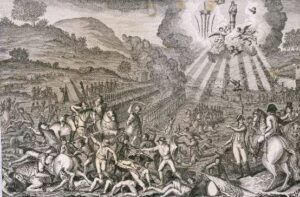 population longed for a miraculous symbol, which they found in a palm-like cloud in May 1808 and the apparition of the Virgin during the Battle of Las Heras in June 1808. [Image at right] During the two bloody sieges suffered by Zaragoza in 1808 and 1809, the population saw the intervention and protection of the Virgin in every event, no matter how small it was.
population longed for a miraculous symbol, which they found in a palm-like cloud in May 1808 and the apparition of the Virgin during the Battle of Las Heras in June 1808. [Image at right] During the two bloody sieges suffered by Zaragoza in 1808 and 1809, the population saw the intervention and protection of the Virgin in every event, no matter how small it was.
From the middle of the nineteenth century until the middle of the twentieth century, the shrine of el Pilar underwent two processes of modernization and politicization that ran in parallel. Following the rise of Marian devotions after the Inmaculada Dogma and the apparition of Our Lady of Lourdes, ecclesiastic authorities and laymen drove the refurbishing of the temple and the renewal of the devotional cultures linked to this shrine (Ramón Solans 2016). At the same time, the secularizing measures implemented by different Spanish governments between 1868 and 1936 raised the need to demonstrate the strength of Catholicism through massive demonstrations. Likewise, the development of a national Catholic political culture made the devotion to Our Lady of the Pillar a core element of their worldview, which ontologically linked being Spaniard and Catholic since the Virgin was the founder of the Spanish Nation and she inspired the great moments of its history.
Both the modernization of the shrine and its politicization were deeply interrelated as we can see with the refurbishing and completion of the basilica. The cathedral was refurbished between 1863-1872 as a national homage of Spain to the Virgin. The second tower of the Cathedral, finished in 1907, was an act of reparation against the 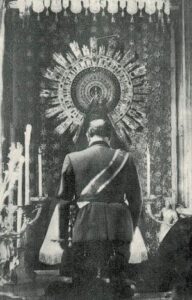 anticlerical riots of the Jubilee in 1901, which was seen to epitomize the “anti-Spain.” During the dictatorship of Franco, the square of the Cathedrals opened a huge space to gather mass religious and political demonstrations before the Basilica and the monument to the “martyrs of the Crusade (1936-1939)” (Ramón Solans 2014). [Image at right] In 1961, the Cathedral was completed by construction of the last two towers; these were funded by a noble woman Leonor Sala, who was close to the dictatorship.
anticlerical riots of the Jubilee in 1901, which was seen to epitomize the “anti-Spain.” During the dictatorship of Franco, the square of the Cathedrals opened a huge space to gather mass religious and political demonstrations before the Basilica and the monument to the “martyrs of the Crusade (1936-1939)” (Ramón Solans 2014). [Image at right] In 1961, the Cathedral was completed by construction of the last two towers; these were funded by a noble woman Leonor Sala, who was close to the dictatorship.
DOCTRINES/BELIEFS
The Cathedral of Our Lady of the Pillar is a recognized Catholic site of pilgrimage. The Catholic Church has never confirmed the veracity of this Marian apparition, but rather the pious tradition linked to it. Given the antiquity of the apparition and the lack of historical evidence, the Holy See has never taken a stance on the truth of the events which gave birth to this shrine. Nevertheless, this shrine and the devotion to the Virgin of the Pillar has been constantly fostered by local, national, and Vatican religious authorities. The devotion as well as the cathedral have benefited from different papal grantings, and in 1982 and 1984 John Paul II visited the Cathedral, praising the Virgin of the Pillar. The Shrine of the Pillar has also contributed by giving shape Marian devotional cultures both in Spain and in the Catholic world. As a matter of fact, two Marian International Congress were held in Zaragoza in 1908 and 1979 to define global Catholic Mariology.
Since the seventeenth century, this religious symbol also has come to epitomize local and regional identities. The Virgin was declared patronnes of Zaragoza and Aragon in 1653 and 1678. The Virgin was also reinvented as a national symbol within the emergence of the National Catholic political culture by the second half of the nineteenth century. National-Catholicism was a monarchist, anti-liberal, anti-communist, anti-individualist, authoritarian and militarist worldview that dominated Spanish Catholicism until the second half of the twentieth century. Within this political culture, the Virgin of Pillar became a rallying symbol against secularizing policies, which “corrupt” the true Spanish soul.
The Virgin of the Pillar became a core element of the National-Catholic interpretation of the Spanish History (Ramón Solans 2014). The coincidence between the festivity of the Pillar and the date of the “discovery” of America was used to sacralize the Spanish Empire and its providential mission. In 1908, the offering to the Virgin of nineteen flags of Latin-American Republics blessed by the pope came to consolidate this interpretation of the Spanish History (Ramón Solans 2017). During the Dictatorship of Franco, the Virgin was declared queen of the Hispanidad (Hispanicity) and its sanctuary, the Santuario de la Raza (Sanctuary of the Race). Within this Catholic diplomacy, Our Lady of the Pillar was declared patronness of the Consejo Superior de Misiones in 1948, and her image was spread all over the world.
The second milestone in Spanish History was the Catholic inspiration of the defense of Zaragoza during the two sieges of the Napoleonic army. This interpretation nurtured the declaration of the Cathedral of Our Lady of the Pillar national monument, and within the context of the one-hundredth anniversary of the War the Virgin was proclaimed Captain General of the Spanish Army in 1908. Following these honors, the Virgin of the Pillar was declared patronness of the Guardia Civil (Civil Guard) (1913), Correos (Postal Service) (1916), Cuerpo de secretaries, interventores y depositarios de administración local (1928), Sociedad mariológica (1940), Consejo superior de misiones (1948) and the submarines of the Spanish Navy (1946).
The Political Culture of National Catholicism reached its zenith during the Francoist Dictatorship. The proximity between the end of the Civil War in 1939 and the 1900th Anniversary of the Apparition of the Virgin in Zaragoza in 1940 opened an intense cycle of religious and political celebration of the so-called Spanish crusade against 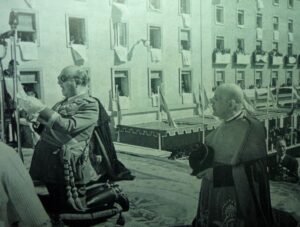 communism (Cenarro Lagunas 1997). During this time, the cathedral became the center of sacralization of the new regime. Besides the honors granted to the Virgin of the Pillar, in its Basilica, Franco consecrated the whole country to the Virgin Mary in 1937; the president of the Francoist Cortes, Esteban de Bilbao, consecrated Spain to the defense of the Assumption dogma; and again the dictator consecrated Spain to the Sacred Heart of Mary during de Nacional Marian Congress held in Zaragoza in 1954. [Image at right]
communism (Cenarro Lagunas 1997). During this time, the cathedral became the center of sacralization of the new regime. Besides the honors granted to the Virgin of the Pillar, in its Basilica, Franco consecrated the whole country to the Virgin Mary in 1937; the president of the Francoist Cortes, Esteban de Bilbao, consecrated Spain to the defense of the Assumption dogma; and again the dictator consecrated Spain to the Sacred Heart of Mary during de Nacional Marian Congress held in Zaragoza in 1954. [Image at right]
In the late 1950s and 1960s, this highly politicized and nationalized model showed some signs of exhaustion and, under the guidance of the technocrats of Opus Dei, evolved to a form more suitable to tourism and a modern economy. The aggiornamento of Roman Catholicism after Second Vatican Council played a critical role in the fostering of a new Marian devotional culture closer and less political. The regionalist and cultural dimension of this devotion eased the evolution from the ‘Sanctuary of the Race’ to a cultural heritage site which embodies the identity of Aragon. In 1962, the patron saint festival of October 12 was declared of national tourist interest, and its folkloric and regionalist dimension were emphasized. In this regard, the invention of the tradition of the parade in regional costumes to offer flowers to the Pillar played a critical role. Following the model of the Virgin of the Desamparados in Valencia, the City Council introduced this successful tradition in Zaragoza in 1958.
The regionalist and touristic turn contributed to the depoliticization of this religious symbol, easing its transition to democracy. From 1975 on, the Virgin of the Pillar evolved into a religious symbol deeply embedded with local and regional identities. An example of the latter would be the tradition of offering to the Virgin of the Pillar the football trophies won by the local team Real Zaragoza, as in 1995 with the UEFA Cup Winners’ Cup.
Finally, the popularity of this devotion explained the belief in its capacity of mediation and protection, which is linked to the mantle (manto) that cover the pillar on which the Virgin has appeared. Sometimes these beliefs exceeded the Catholic orthodoxy and were intolerable to the local religious authorities. This is the case with the familiar and the informal relationship of the population of Zaragoza. The Virgin of the Pillar is called by her diminutive “la pilarica” and the people of Zaragoza go “to visit” the Virgin as if she was a relative or a friend. This also explains why visitors of the Virgin are not necessarily Catholic believers.
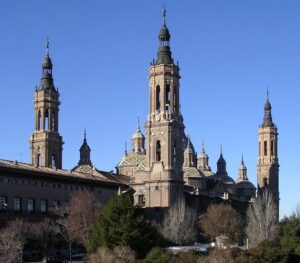
RITUALS/PRACTICES
The popular and political character of this devotion explains the great variety of rituals and religious practices linked to the Pillar. We can further distinguish amongst regular religious practices and the extraordinary mass pilgrimages that have taken place to her basilica. The Cathedral [Image at right] is the center of the momentous events in the life of the faithful and overall inhabitants of Zaragoza. Children under the age of communion are presented to the image of the Pillar to be protected by her mantle. Another sign of protection and devotion is the colored ribbons cut to the length of the Pillar which have been sold in the Cathedral and used to adorn vehicles and other objects. During their “visit” to the Virgin, believers wait in line to kiss the uncovered part of the original pillar.
The Virgin is displayed in the Santa Capilla (Holy Chapel) with her mantel, except on the second, twelfth, and twentieth of every month, when the Pillar is exhibited 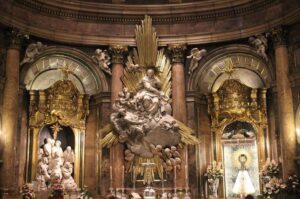 unadorned in memory of the apparition (January 2), the day of the Pillar (October 12) and the coronation of its image (may 20). [Image at right] The Holy Chapel is surrounded by plaques in memory of pilgrimages, and her patronnes and protection. From Monday to Saturday, the Rosary is prayed in the Holy Chapel, and three times a day the ejaculatory prayer “Bendita y alabada sea la hora” (“blessed and praised is the time”) is sung by the infanticos (altar boys).
unadorned in memory of the apparition (January 2), the day of the Pillar (October 12) and the coronation of its image (may 20). [Image at right] The Holy Chapel is surrounded by plaques in memory of pilgrimages, and her patronnes and protection. From Monday to Saturday, the Rosary is prayed in the Holy Chapel, and three times a day the ejaculatory prayer “Bendita y alabada sea la hora” (“blessed and praised is the time”) is sung by the infanticos (altar boys).
The weeklong patronal feast of Our Lady of the Pillar is one of the most important events in Zaragoza city life. Amongst the religious ceremonies of the annual festival in honor of the Virgin of Pilar, two events stand out. Since 1958, every October 12 faithful dressed in regional costume parade to offer flowers to the Virgin of the Pillar and a flower mantle is created around the copy of the image displayed in the square. Since 1889, the brotherhood of the Glass Rosary parade takes place through the streets of Zaragoza, with illuminated crystal floats during the night of each October 13.
Beside these regular and traditional ceremonies, mass pilgrimages have been used to epitomize the Catholic body of the nation and fight against secularizing policies. The National Pilgrimage of 1880 to the Pillar paved the way for massive pilgrimages in Spain with around 20,000 visitors and a modern organization, including arrangement of transport by railway, lodging, guided visits, etc. The canonical coronation of the Virgin of Pilar in 1905 attracted a national pilgrimage, with 45,000 pilgrims from all over Spain. This national homage to the Virgin of Pilar was offered as an act of Reparation for the confrontation with anticlerical groups which took place in Zaragoza during the Jubilee of 1901.
Between 1905 and 1925, 101 pilgrimages were organized just to el Pilar, among which were ten international, eight national, and eighty-three regional. The Spanish Nightly Adoration of the Blessed Sacrament also organized a National Vigil in 1907 in front of the altar of the Virgin as a sign of reparation for these anticlerical attacks. The organizers claimed that 250,000 people received communion the next day. The centenary of the First Siege of Zaragoza (1808) during the Spanish War of Independence contributed to the consolidation of the national tone of the worship of el Pilar. Thirteen regional and local pilgrimages were organized to thank the Virgin for defending Zaragoza and Spain against Napoleon. The Nightly Adoration of the Blessed Sacrament performed a National Vigil with 387 sections and 11,000 pilgrims to commemorate the Spanish War of Independence, the fiftieth anniversary of Lourdes, and the jubilee of the priesthood of Pius X.
From 1912 on, an annual pilgrimage was performed each May from a given ecclesiastical province in commemoration of the Coronation of the Virgin of el Pilar. The female devotional association Corte de Honor de Damas del Pilar fostered this annual pilgrimage, coordinating the diocese of Zaragoza with the ecclesiastical province traveling that year. From 1917on, this pilgrimage, as well as others, disappeared, emerging again during Franco’s dictatorship as an act of gratitude to the Virgin for the victory in the Spanish Civil War. During the dictatorship of Primo de Rivera, pilgrimages were replaced by military parades to celebrate the victories in the colonial Rif War (1920-1927), such as the national ceremony in 1927.
The separation of church and state during the Spanish Second Republic galvanized all kinds of catholic mobilization. The Virgin of the Pilar became once again a rallying symbol against secularization. The removal of its image from Zaragoza Council Chamber in 1932 sparked protests, such as the gathering of 30,000 signatures of Zaragoza women. There were several national pilgrimages to el Pilar in 1932 and 1933. Renovación española, a Spanish ultra-monarchist political party, and the Carlists, a Spanish legitimist group, organized a pilgrimage in 1935 to el Pilar as an act of reparation for the Revolution of Asturias and expression of gratitude for its repression.
During the first years of Franco’s dictatorship, pilgrimages to the Virgin of el Pilar reached their peak as an expression of National Catholic ideology. In the spring of 1939, around 235 villages and cities of Aragon made a pilgrimage to Zaragoza to celebrate the victory in the Spanish Civil War. In the autumn of that year, pilgrims from several dioceses, Catholic Action Youth, and the Nightly Adoration of the Blessed Sacrament, came to Zaragoza to thank the Virgin for her intercession during the war. In 1940, the commemoration of the XIX Centenary of the Apparition of the Virgin in Zaragoza brought the capital of Aragon 125 pilgrimages (one international, four national, 48 diocesan, twenty-eight parochial, twenty-five school, and nineteen from different organizations and professions) and 130,000 visitors.
ORGANIZATION/LEADERSHIP
The rise and development of the devotion to Our Lady of the Pillar is the result of the combined efforts of political authorities, ecclesiastic structures and Catholic lay organizations. Closely linked to the identity of Zaragoza, the city council promoted not only the patron feast of the Virgin of the Pillar but also different religious and honorary granting to its symbol. Thanks to its collaboration, urban planning was adapted religiously so the centrality of the Basilica in Zaragoza could be reinforced. National and regional governments also contributed to the development of the shrine in order to reinforce their legitimacy and foster a National Catholic Spanish identity.
The development of this shrine would not have been possible without the cooperation and initiative of a significant part of the Catholic hierarchy of Zaragoza, and particularly of its archbishops. This was particularly true in the case of the prelates who undertook the renewal of the shrine between 1858 and 1955: Manuel García Gil (1858-1881), Juan Soldevila y Romero (1902-1923) and Rigoberto Doménech (1924-1955). Closely related to the initiatives of these archbishops was the council of canons of Zaragoza, and specially the dean Florencio Jardiel (1906-1931) and José Pellicer (1931-1940).
The dense network of Catholic associations in Zaragoza, from the devotional and charity associations to the different groups integrating the Catholic Action, played a major role in the organization and promotion of the above-mentioned initiatives linked to the shrine of the Pillar. Particularly important were two lay associations. These two worked to promote devotion to the Pillar and to pray and keep vigil in the Holy Chapel of the Virgin: the female “Corte de honor de damas de Nuestra Señora del Pilar” (1902) and the male “Caballeros de Nuestra Señora del Pilar” (1928).
ISSUES/CHALLENGES
During the sacred creation process, this devotion confronted a lack of evidence to support the veracity of the tradition. The growing importance of this shrine aroused suspicion in the rival council of canon of the cathedral of the Savior, which attacked the tradition as a forgery. Later, during the Enlightenment, the devotion was attacked as a superstitious tradition, which needed to be eradicated from a new and purified catholic doctrine. Nevertheless, none of these critics posed a serious challenge to the growing popularity and importance of the Virgin of the Pillar, and they were even repressed by the Bourbon dynasty (Serrano Martin 2014). The pages devoted to challenging the truth of the apparition of the Virgin in Zaragoza in the Synopsis historica chronologica de España (1700-1727) of Juan de Ferreras were ripped out by royal decree.
The devotion to Our Lady of the Pillar also has confronted the modern challenges of secularization and the creation of pluralistic and multi-denominational societies. The Virgin of the Pillar was closely linked to the authoritarian National-Catholic political culture, and therefore it was used as a rallying symbol against secularization. Since the 1960s, the main challenge has been to depoliticize religious symbolism and to adapt to the new democratic Spain.
IMAGES
Image #1: Gravure of the Battle of Las Heras (1808). Spanish National Library.
Image #2: Franco before the Virgin. Doce de Octubre, 1-194 (1939).
Image #3: Franco consecrated Spain to the immaculate Heart of Mary before the Pillar. Cronica del Congreso Mariano Nacional de Zaragoza, Zaragoza, Noticiero, 1957.
Image #4: The Basilica of Our Lady of the Pillar, in Zaragoza, Spain. Work of Willtron.
Image #5: Santa Capilla (Holy Chapel),
REFERENCES
Cenarro Lagunas, Ángela. 1997. “La reina de la hispanidad: fascismo y nacionalcatolicismo en Zaragoza, 1939-1945.” Revista de Historia Jerónimo Zurita 72:91-101.
Narbona Cárceles, María 2012. “Le Saint Pilier et l’édicule de Sainte-Marie-la-Majeure de Saragosse dans l’esprit de la Première Croisade.” Pp. 85-99 in Matérialité et immatérialité dans l’Église au Moyen Âge. Bucharest: Centre d’Études Médiévales / New Europe Collège / Université Charles-de-Gaulle Lille 3.
Ramón Solans, Francisco Javier. 2017. “La fiesta de las Banderas. Hispanoamericanismo católico en Santiago de Chile, Zaragoza y Buenos Aires (1887-1910).” Mélanges de la Casa de Velázquez, 47:229-47.
Ramón Solans, Francisco Javier. 2016. “A New Lourdes in Spain: The Virgin of El Pilar, Mass Devotion, National Symbolism and Political Mobilization.” Pp. 136-67 in Marian Devotions, Political Mobilization, and Nationalism in Europe and America, edited by Roberto Di Stefano and Francisco Javier Ramón Solans. New York: Palgrave Macmillan.
Ramón Solans, Francisco Javier. 2014. La Virgen del Pilar dice… Usos políticos y nacionales de un culto mariano en la España contemporánea. Zaragoza: Prensas de la Universidad de Zaragoza.
Ramón Solans, Francisco Javier. 2014. “Un templo para la nación española: la Basílica del Pilar (1854-1940).” Hispania Sacra, extra I:7-31.
Serrano Martin, Eliseo. 2014. “Silentium facite: El fin de la polémica y el discurso en torno a la Virgen del Pilar en la Edad moderna.” Hispania 248:687-714.
Publication Date:
5 June 2020
